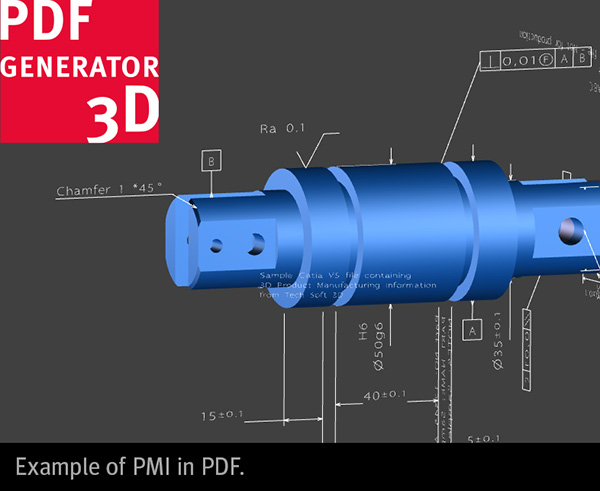
|

Continental relies on drawing-free processesBy Timo Trautmann Nowadays, everyone is talking about model-based definition (MBD) and model-based enterprise (MBE). The technology company Continental is getting down to brass tacks and replacing conventional 2D drawings with native CAD models and 3D PDF documents with embedded PMI (product manufacturing information). It has been more than ten years since the technology company Continental made the move to 3D master models with fewer drawings. Nevertheless, 2D drawings remained indispensable for many processes, both internally and in the context of its communications with suppliers. But now the company is going a step further and replacing these drawings with native CAD models and 3D PDF documents with embedded PMI (product manufacturing information). 
Nowadays, everyone is talking about model-based definition (MBD) and model-based enterprise (MBE). The thrust of this concept is to associate the information that would normally be contained in the drawings with the 3D model as PMI so that it can be used for quality assurance, manufacturing and other tasks, thus largely eliminating the need to create drawings at all. Continental is currently gaining initial experience with implementing the concept in various pilot projects in the company’s Automotive division, explains Constantin von Bernuth, IT expert for mechanical product design at Continental. With annual sales of 39.2 billion euros and a workforce of approximately 215,000, the Continental Corporation is one of the biggest technology companies in the world. Founded more than 140 years ago, the company develops, manufactures and markets innovative solutions for safe mobility, intelligent driving, worldwide mobility and environmentally-friendly powertrains at 430 sites in 55 countries. The corporation is headquartered in Hanover and comprises the divisions Interior, Powertrain, Chassis & Safety, Tires and ContiTech. Like many other automotive suppliers, Continental has a heterogeneous CAD environment with PTC Creo and Catia V5 as the two leading mechanical design systems. The MBD initiative was driven by two things: On the one hand by the Testing department, which was looking for more efficient ways of controlling the CT scanners and measuring equipment, and on the other hand by the stated aim of many car manufacturers of wanting to dispense with drawings in the foreseeable future. The priority was not to reduce the outlay involved in creating drawings, but far more to exploit the time savings in the downstream processes, as von Bernuth points out: "The direct savings are actually not that large. After all, much of what used to be recorded in the drawings still has to be recorded in the 3D model." Investigations by Continental showed that it was possible to dispense with between 10 and 15 percent of the annotations because individual elements no longer had to be created in different views. Evaluation of the PMI information When establishing the drawing-free process, Continental based its concept on VDA Guideline 4953-2, which describes a reference process covering creation of the user data in the CAD or PLM system, generation and distribution of the 3D documents, and the use of documents in various use cases. To supplement this, DIN ISO 16792 specifies how dimensions, tolerances and other PMI are to be associated with 3D models. For example, the standard requires that the information must be selectable, i.e. not all element types, such as references, tolerances and surface quality, are allowed to be located in one (isometric) view. It is, however, possible to create additional 2D detail views in which they can be mixed. One of the use cases for the drawing-free process that was implemented by Continental several years ago is quality control. This involves passing the PMI from the Creo models to the scanning software in order to check that the geometrical tolerances of the actual model are within specification. Any discrepancies are highlighted on a false-color model and listed in a report. It should be noted that it is not the geometries of the CAD model and the scanned model that are being compared but rather target values and actual values, which is a far more accurate comparison. "We used to have to re-enter the tolerances on the scanned model, which was a very time-consuming job," explains von Bernuth. "The automatic transfer of PMI information has significantly reduced the time needed." Within the company, the MBD data is used not only in the Testing department, but also in Purchasing and Research & Development. The primary external recipients are the toolmakers and the suppliers that manufacture certain components for Continental. If drawings are to be dispensed with completely, it is of course necessary that all the employees at the company and in the supply chain are able to visualize the annotated 3D models. The company's own employees are able to use Creo View. Solution for external communication To allow the MBD data to be communicated to external partners, Continental needed a solution that did not require suppliers to install any special software and which at the same time kept the internal effort involved in conditioning the viewing data to a minimum. And the company found this solution in the shape of PROSTEP's 3D PDF technology. Unlike other neutral formats that were considered, 3D PDF has the advantage that any 2D documents can be embedded in the containers alongside the 3D models and the views with the PMI. And, if needed, STEP or native CAD data can also be embedded. Continental also evaluated STEP, albeit still with purely graphical PMI that cannot be further processed. The suppliers did not find this particularly useful, as von Bernuth explains: "But I'm expecting that STEP AP 242 and JT, together with the possibility of transferring semantic PMI, will in future allow some of the information to flow into neutral models, where it could, for example, be used directly for CAM programming." This means that at the moment, the 3D PDF documents only replace the drawing itself. In other words, the suppliers have to incorporate the dimensioning and tolerance data into their CAM programs manually. With the help of PROSTEP's PDF Generator 3D and suitable templates, the annotated Creo and Catia models are automatically converted into 3D PDF documents, which means that there is no extra work for the designer. In addition to the 3D models, the 3D PDFs also contain drawings or 2D views, comments, specifications and references to the relevant standards: "3D PDF is capable of far more than just using 3D content to improve comprehensibility," explains von Bernuth. "For example, it's possible to protect individual attachments and the know-how they contain using digital signatures. This was an important selection criterion for us." 
Creation of change reports The 3D PDFs have a uniform structure and contain "comfort buttons", which take the user directly to those views that contain specific PMI. With a simple click, it is possible to set hidden-line mode, define the center of rotation or change the background color of the model to make it easier to read the PMI. "Users also have the option of aligning the model, toggling specific PMI on or off and printing the view they want," says von Bernuth. In principle, Continental permits printing but has hidden certain functions in order to keep the files as easy as possible to use. In the future, it is intended that the 3D PDFs will be generated automatically in the SAP release process. The 3D PDFs are extremely easy to use and enjoy a high level of acceptance among the suppliers. For the design engineers and draftspeople who have to create the PMI in Creo or Catia, on the other hand, implementation of the MBD brought significant changes. The IT team at Continental provided them with support by defining uniform working methods and providing appropriate training. Creation of the PMI is also made easier by the use of tools such as the GD&T Advisor, which guides users through the model and only offers them the geometrical tolerances that make sense within the given context. These tools also perform plausibility checks, which help to improve the data quality. The drawing-free process is still being piloted at Continental, so von Bernuth cannot yet say how it will affect lead times. But one thing that is already apparent is that it helps improve process reliability. Currently, the most important benefit is the option of comparing the CAD models converted using the PDF Generator 3D with the respective previous version and to display any changes to the PMI highlighted in color in a table. "The possibility of exporting change reports is a huge benefit that PROSTEP effectively gave us out-of-the-box, and it is something we had not been expecting," says von Bernuth in conclusion. 
|
|
| © PROSTEP AG | ALL RIGHTS RESERVED | IMPRESSUM | DATENSCHUTZERKLÄRUNG | HIER KÖNNEN SIE DEN NEWSLETTER ABBESTELLEN. |
